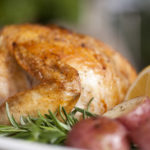About 30 years ago research linked eating red meat to heart disease. So, we all started eating a lot more chicken. In 1960 the average adult ate 28 pounds of chicken a year; in 2015 that number had climbed to 90 pounds. Yes, the average American adult eats 90 pounds of chicken a year.
That’s a LOT of chicken. So we should all be getting thinner and healthier, right? 
Hmmm…Maybe chicken isn’t as healthy as we thought.
A recent study explains some of it. The EPIC – PANACEA study studied over 370,000 people and found that even when total calories eaten were the same, people who ate more chicken had greater rates of obesity. Yes, you read that correctly – eating chicken was correlated with higher rates of obesity.
Chicken was associated with obesity even more than red meat. Fun fact: in 2015 the average person ate 54 pounds of red meat, down from 63 pounds in 1960. Not nearly as big of a jump as chicken, which means we are eating a lot more animals than we used to eat.
While one study does not provide all the answers, this is a very big study and can’t be ignored.
I started doing more research to find why this might be true and what I found was startling.
1. To keep up with demand for chicken products, chicken farmers have found ways to make the birds grow fatter faster – a lot faster. It makes sense that birds bred to be obese are making the people who eat them obese.
2. The environment these chickens live in is unhealthy so they are given antibiotics to prevent disease, make them get fat, and get them to market quickly. There are many studies linking antibiotics with weight gain for both animals and humans. Its possible the antibiotics the chicken are fed to fatten them up are fattening us up as well.
3. Two viruses have been found so far that promote obesity, and they are common in chickens. While these viruses should be killed by cooking the chicken thoroughly, there is evidence that they spread easily, so the people who work with chickens may be spreading it around their communities and then out into the world. We may also pick them up while handling raw chicken that is infected. People who have been exposed to these viruses store more of their food as fat and make more new fat cells, even when they eat exactly as much as people without the virus.
I don’t want to alarm you. These viruses are like the common cold virus and do not make us severely ill. Right now there is no test available in the average doctor’s office, and there is some evidence that people who have been exposed to these viruses can lose the extra weight.
We often put the blame on sugar for all of our health issues, but it is becoming more and more evident that eating a lot of animal products contributes to them too.
So, what now? What do we eat instead of all of this chicken? Is any amount of chicken safe?
Those are all good questions that need more research for definitive answers. In the meantime I recommend making a few dietary modifications.
The first step is adding some plant-based protein sources to your diet. Instead of always adding chicken to a salad, try adding chickpeas, beans (any color!), lentils, or edamame. Whole grains like quinoa, farro and brown rice as well as hearty vegetables keep us full and are also good sources of protein. Yes, broccoli has protein!
Try making two or three days a week meatless and chickenless and see how you feel. Summertime makes it easier to try this, with all of the wonderful produce in the market and the appeal of salads when its hot outside.
Try this salad to get started:
To serve 2 people:
1 can white kidney beans or chickpeas, drained and rinsed
1 avocado, chopped
1 pint cherry tomatoes, halved
1/2 red onion, chopped or 3-4 scallions, sliced
2-3 radishes, sliced thinly (add the tops too if you have them)
Juice of 1/2 – 1 lemon
Salt and pepper
Squeeze lemon onto the avocado to prevent browning. Combine all the ingredients and toss to taste with your favorite olive oil based salad dressing, salt and pepper to taste. You can easily double this salad. Add any other veggies you like and leave out what you don’t. It keeps for 2-3 days in the fridge and travels well.
Scoop some onto lettuce leaves or baby spinach for a hearty salad, or stuff into a whole-wheat pita pocket for a quick, delicious sandwich. Its also good on top of some whole wheat crackers, or topping a brown rice bowl.
Next week you can make a Mexican version, with black beans, corn, avocado, tomato, onion, and a lime or cilantro dressing. Even easier, toss black beans with store-bought pico de gallo, chopped avocado and some corn and make veggie tacos, burritos or a taco salad.
Enjoy!
Leave a Reply